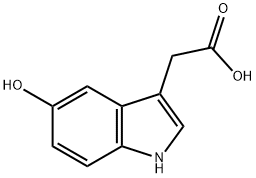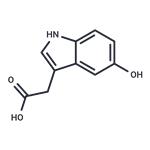Description
5-hydroxy Indole-3-acetic acid (5-HIAA) is the primary metabolite of serotonin (5-HT; ). It is formed when 5-HT is metabolized by monamine oxidase and aldehyde dehydrogenase in the liver. 5-HIAA is excreted in urine and has been used as a biomarker for detection of neuroendocrine tumors and an internal standard for the quantification of serotonin metabolism in rat brain using mass spectrometry. 5-HIAA has also been associated with autism, insomnia, and chronic migraine.
Chemical Properties
beige crystalline powder
Uses
5-Hydroxyindole-3-acetic acid is a major serotonin metabolite.
Uses
5-Hydroxyindole-3-acetic acid is an impurity of chlorpheniramine (C424300), an antihistaminic agent.
Definition
ChEBI: A member of the class of indole-3-acetic acids that is indole-3-acetic acid substituted by a hydroxy group at C-5.
General Description
5-Hydroxyindole-3-acetic acid (5-HIAA) is the catabolic end product of serotonin pathway. 5-HIAA is present in body fluids like cerebrospinal fluid (CSF), blood and urine. The expression levels of 5-HIAA is different among the normal and cancer patients. Sepiapterin reductase deficiency results in low level of 5-HIAA in CSF. 5-HIAA level is low in CSF in patients with bipolar 1 disorder with childhood attention-deficit hyperactivity disorder (ADHD).
Mechanism of action
The primary
product of the metabolism of serotonin. Formed by the oxidative
deamination of serotonin by monoamine oxidase, presumably
the A isozyme, 5-HIAA is subsequently cleared by an
active transport mechanism. Unlike serotonin, 5-HIAA is not a
neurotransmitter and thus its formation contributes to the termination
of the synaptic actions of serotonin. Inhibition of
monoamine oxidase activity enhances and prolongs the actions
of serotonin.



